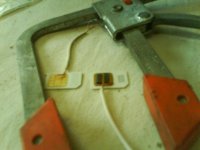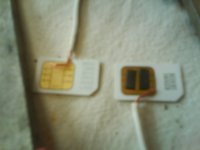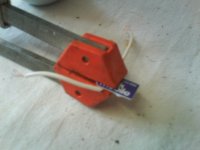Steve, you are right. There can be no possible relevance to a Bybee filter. After all, what could Jack Bybee know about physics? He CLAIMS to have a MS in physics from UCB, but you know different, right. He CLAIMS to have worked with Richard Feynman, but we all know that would be impossible, right? Well, let's leave it at that.
Steve, you are right. There can be no possible relevance to a Bybee filter.
No, I said you've not given any relevance to it. You just keep dancing around like you're doing right now.
So what's the relevance, John?
If you can't say, then what's the point other than just wasting bandwidth?
se
Well everyone, I can't help any further.
You didn't help any more than if you'd have said nothing at all.
se
Hi,
That is patently untrue.
Many MM Cartridges have a shield incorporated that is connected to one of the ground leads. Running such a cartridge balanced without modification (remove the connection to the pin and run a separate ground) will cause significant hum.
Yes. Exactly. And most (note, I do not say all - as I do not know all manufacturers and all products and hence would likely invite the falsification of any dogmatic statement) commercial Arm/Table manufacturers terminate their arm-wires into RCA Plugs. Most Turntable owners will not rewire their arms (many are near impossible to do anyway).
So there is zip, zilch, nada point for a commercial product manufacturer to introduce a balanced phono stage, even if they could solve the problem of the worse S/N Ratio in a balanced design (well it can be solved by doubling the number of input devices).
So basically you are lambasting manufacturers for not making products that have no market? Well, that is a funny view... 😛
For DIY this is an option, but as for my DIY I invariably use step-up transformers for MC the whole questio nis moot and I can retain the original wiring AND keep my Phonostage single-ended, which to my ears sounds subjectively better than the same topology balanced.
Ciao T
All phono cartridges are naturally balanced. They have a + & - output for each channel, there is no ground.
That is patently untrue.
Many MM Cartridges have a shield incorporated that is connected to one of the ground leads. Running such a cartridge balanced without modification (remove the connection to the pin and run a separate ground) will cause significant hum.
It's down to how the thing is wired out from the record deck & to the pre-amp or phono stage that usually makes the thing single ended.
Yes. Exactly. And most (note, I do not say all - as I do not know all manufacturers and all products and hence would likely invite the falsification of any dogmatic statement) commercial Arm/Table manufacturers terminate their arm-wires into RCA Plugs. Most Turntable owners will not rewire their arms (many are near impossible to do anyway).
So there is zip, zilch, nada point for a commercial product manufacturer to introduce a balanced phono stage, even if they could solve the problem of the worse S/N Ratio in a balanced design (well it can be solved by doubling the number of input devices).
So basically you are lambasting manufacturers for not making products that have no market? Well, that is a funny view... 😛
Change the wiring & get yourself (or build) a phono stage with balanced inputs & you are laughing 😀
For DIY this is an option, but as for my DIY I invariably use step-up transformers for MC the whole questio nis moot and I can retain the original wiring AND keep my Phonostage single-ended, which to my ears sounds subjectively better than the same topology balanced.
Ciao T
For DIY this is an option, but as for my DIY I invariably use step-up transformers for MC the whole questio nis moot and I can retain the original wiring AND keep my Phonostage single-ended...
Though due to the use of the step-up transformers, the input will be balanced, even if using RCAs (I know you already know this, just mentioning it for others).
se
Steve,
Sorry for omitting that. I kind of felt that it was so obvious, I did not want to insult the readers intelligence.
Thanks for the correction.
Ciao T
Though due to the use of the step-up transformers, the input will be balanced, even if using RCAs (I know you already know this, just mentioning it for others).
Sorry for omitting that. I kind of felt that it was so obvious, I did not want to insult the readers intelligence.
Thanks for the correction.
Ciao T
That is patently untrue.
Many MM Cartridges have a shield incorporated that is connected to one of the ground leads. Running such a cartridge balanced without modification (remove the connection to the pin and run a separate ground) will cause significant hum.
Actually, "event horizon" is technically correct, in that cartridges are usually inherently balanced by design. As you say, the usual form of grounding is by inserting a small tag between the case of the cartridge and its chassis, and the other end of the tag fits over one of the (grounded by convention) pins. This tag is easily removed if required. I have occasionally had to do this, for example at one time I lived directly under the aerial system for a broadcast AM transmitter. I had to go to considerable trouble to keep RF out of my audio equipment.
... And most (note, I do not say all - as I do not know all manufacturers and all products and hence would likely invite the falsification of any dogmatic statement) commercial Arm/Table manufacturers terminate their arm-wires into RCA Plugs. Most Turntable owners will not rewire their arms (many are near impossible to do anyway).
Most tone-arms are wired as balanced from the cartridge connections to the connection at the bottom of the arm pedestal. (4 fine wires, twisted together, no shield.) I modified my tone-arms to "4 wire with shield" from the pedestal to the preamp. The conversion to unbalanced occurred inside the preamp case (I used DIN plugs / sockets, not RCA).
The reason for grounding a phono cartridge shell / chassis is mostly for static pickup problems, not induced hum.
The cartridge shell or chassis design is responsible for shielding the coils from external magnetic fields, and grounding the shell / chassis does not help with this. In my cases, I just made sure the cartridge shell was bonded to the arm tube. On one arm I had to run a very fine wire from the arm tube to the turntable subchassis.
One time I also removed a tag where there was a ground loop causing hum - there was continuity from the cartridge body, via the headshell, arm tube, pedestal, and turntable subchassis to mains earth. It was easier to remove the tag rather than try to insulate the cartridge from the headshell.
So in summary, in my experience it's usually easy to convert to balanced configuration, and sometimes necessary. Whether you then feed it into a balanced preamp is optional.
Or you could just insert quantum purifiers into the leads...
diy
my take on the subject.
I have no idea what Mr Bybee makes.
This is a Quantum Tunneling resistor.
Regards Max
ps The blobby bits are "Peratech" pills
my take on the subject.
I have no idea what Mr Bybee makes.
This is a Quantum Tunneling resistor.
Regards Max
ps The blobby bits are "Peratech" pills
Attachments
Last edited:
my take on the subject.
I have no idea what Mr Bybee makes.
This is a Quantum Tunneling resistor.
Regards Max
ps The blobby bits are "Peratech" pills
I see you have added the "ET 'phone home" option.
IKO, you are showing that you have no experience, and no understanding of Bybee devices, and you haven't even read the brochure on them. Please don't waste my time with such questions. Thanks in advance.
The question is, is it worth the effort learning about these devices? 😀😀😀
Personally, I don't want to end up with a broken common sense due to pseudoscience overdose.
Pseudoscience is like drugs, use it with care.
Several obviously well learned people are contributing to this discussion who clearly DO know a thing or to about this very esoteric subject. You just dismissed and devalued those here in a most obnoxious way.
A recurring modus operandi .....
Ok - I am not going to join the "reindeer games" of pointing fingers, insults and flaming. I have no interest in that. But I do have an interest in expanding my limited knowledge of physics, electronics and audio, so I am going to revert back to technical questions.
In the paper that John referred to, I did note that the heated metal contacts were metals of relatively low conductivity - why wasn't copper or silver used? Perhaps the propensity to oxidize? I can't recall, but did the resistance of the nanotube remain constant regardless of the metal used (I think it did, but am going off my memory here)? Oh my head hurts.....
To respond to one valid question posed to me - why have them in the path at all given my attempt at an explanation.... well, when I think about it - that is a damn fine question. I don't know, because as that poster pointed out, if my explanation is reasonably correct, then the device does not appear to DO anything. Very good point... And yes, I realize that brings the conversation back into the "snake oil" realm, but I am still neutral on the issue.
In the paper that John referred to, I did note that the heated metal contacts were metals of relatively low conductivity - why wasn't copper or silver used? Perhaps the propensity to oxidize? I can't recall, but did the resistance of the nanotube remain constant regardless of the metal used (I think it did, but am going off my memory here)? Oh my head hurts.....
To respond to one valid question posed to me - why have them in the path at all given my attempt at an explanation.... well, when I think about it - that is a damn fine question. I don't know, because as that poster pointed out, if my explanation is reasonably correct, then the device does not appear to DO anything. Very good point... And yes, I realize that brings the conversation back into the "snake oil" realm, but I am still neutral on the issue.
non logged in users!
Please be aware that the picture titles in my previous post are a product of my complete inability to manage Bluetooth and computers and my son's revision notes.
Apologies for OT.
Regards Max Albin
ps If a mod could alter them to 1,2,3 I'd be ecstatic.
Please be aware that the picture titles in my previous post are a product of my complete inability to manage Bluetooth and computers and my son's revision notes.
Apologies for OT.
Regards Max Albin
ps If a mod could alter them to 1,2,3 I'd be ecstatic.
Last edited:
Texas, I will try to answer your question, because it is reasonable. First, liquid silver or liquid copper is tough to get at near room temperature. The FINAL contact IN THIS ONE EXPERIMENT has to be a liquid (metal). However, why have ANY resistor at any location in any electronics necessary? This is just an example of a 'fast' resistor. It is to show how 'fast' (electron) resistors can exist in an exotic form, Beryllium resistors are sort of 'fast' as well. Carbon resistors have 'slow' electron flow, by comparison, because to create the resistance, the individual electrons have to be slowed down by both the circuit path and the number of individual electron collisions/unit length, or the average path-length of the electrons. The more collisions, the more resistance, more or less.
Last edited:
I just thought of a parable that might explain my 'problem' here, especially with 'attitude' by me, as seen by others. Let me try it out.
Let's say I am a high school instructor, talking about the Earth.
In order to get the classes attention, I state: 'The Earth is really NOT round'
Instead of the class saying 'wow' or 'what the ...' certain normally noisy members of the class speak out:
One says, 'I was taught that it was round, and you are not going to talk me out of it'
Another declares, 'I always knew is was flat, because my daddy told me so, and he is smarter than you'
I retort: 'It is not completely round, it is considered to be an 'oblate spheroid' do you know what that is? If not, look it up.'
Of course this was what I was trying to get across, before I was interrupted by the noisy students.
Now, a vice-principal of the school is walking by and he overhears me directing the students to 'look it up' and sends me a note, that his students need to be politely dealt with, and that I can't TELL them to do anything. I can only politely request, or provide a link, because they can't be bothered to do it themselves.
This is how I see the situation on this thread, with regards to me. ;-)
Let's say I am a high school instructor, talking about the Earth.
In order to get the classes attention, I state: 'The Earth is really NOT round'
Instead of the class saying 'wow' or 'what the ...' certain normally noisy members of the class speak out:
One says, 'I was taught that it was round, and you are not going to talk me out of it'
Another declares, 'I always knew is was flat, because my daddy told me so, and he is smarter than you'
I retort: 'It is not completely round, it is considered to be an 'oblate spheroid' do you know what that is? If not, look it up.'
Of course this was what I was trying to get across, before I was interrupted by the noisy students.
Now, a vice-principal of the school is walking by and he overhears me directing the students to 'look it up' and sends me a note, that his students need to be politely dealt with, and that I can't TELL them to do anything. I can only politely request, or provide a link, because they can't be bothered to do it themselves.
This is how I see the situation on this thread, with regards to me. ;-)
Sadly inapt analogy. You've got a buddy who's selling stuff using fraudulent claims. When people say, "Gee, that seems fraudulent and your buddy appears to be lying in order to extract money from suckers," you step in and start talking about cloud systems as a function of phlogiston as a distraction (and at the same time, indicating that you don't really know much about clouds).
John - again, it is likely I am not understanding all the nuances of the test, but for some reason, I thought the had liquified some metals by heating it (obviously no Hg), but the drawing shows a heater beneath the liquid metal holding device and the text discusses heating it. Are the other 2 metals used in the test liquid at normal conditions?
And I think I understand more about your point of slow v. fast resistors. Thanks.
And I think I understand more about your point of slow v. fast resistors. Thanks.
- Status
- Not open for further replies.
- Home
- Amplifiers
- Power Supplies
- diy bybee quantum purifiers?


